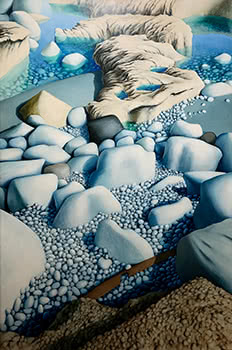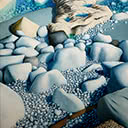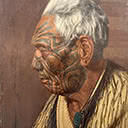Two Rock Pools
183 x 122 cm
est. $500,000 - 750,000
 Relative size
Relative size
PROVENANCE
Collection of R E Smither, New Plymouth Private Collection, Canterbury
EXHIBITED
Taranaki Society of Arts 35th Annual Exhibition, 1967 Benson and Hedges Art Award, Barry Lett Galleries, 1968, cat. no. 23 Taranaki Review Govett-Brewster Art Gallery, cat. no. 46 Michael Smither, An Introduction, Govett-Brewster Art Gallery, 1 November - 16 December 1984
ILLUSTRATED
p. 49 Michael Smither, An Introduction, Govett-Brewster Art Gallery, 1984 p. 90 Michael Smither, Trish Gibben, Ron Sang Publications 2004
Smither spent a great deal of his youth exploring rock pools on the Taranaki coast, and they recur as a subject in his work: That I should go on to paint them was a completely natural and satisfying development and a great way to express my love of the environment. Based on keen observation and detailed pencil drawings made in his notebook, this painting is precise in its delineation of different colours and shapes of stones, offset by a thin diagonal of bull kelp lying across the foreground. Connecting the resemblance of the white rocks which jut out of the substrate to tooth stumps, some commentators have connected the origin of Smither's rock paintings with an ongoing toothache which plagued the artist for many months in 1964. Only by concentrating on repeatedly representing many similar stones on the beach could he reach a state of meditation where the tooth pain was forgotten. Smither wrote: My attempts to express the stillness and peace held deep within the rocks lent the sort of desperation that often attends a breakthrough in vision.
Brilliantly lit by bright sunshine, and filled with cobalt blue sea water, the rock pools of the work's title do not dominate the scene. Instead they are relegated to the upper third of the work, subordinated to the stones which surround them. Tipped up with a kind of vertiginous perspective, the composition mimics the point of view of the studious naturalist who carefully examines what lies at their feet. There is difficult stony ground to be traversed before the oasis of the azure blue pools is reached. The monumental scale of the work accords the subject with considerable importance. Smither himself suggests that water flooding into the rock pools could be interpreted as relating ... to my disturbed nature at the time...I was threatened with eviction from The Gables and had lost the battle to save the clock tower.
Making an abstract pattern, the depiction of the stones and water here show Smither's skill at balancing colour, light and texture. Infinite in their variation, the stones snag the eye and lead it through the composition. The rough brown mudstone in the foreground gives way to a dynamic mid-section where a diagonal band of grey and white stones, contrasting in colour and size, extends beyond the picture frame in both directions. The limpid translucence of the pools beyond is heightened by the rough striations of the volcanic rock that bisects them. Carved by the action of sand and sea, the rocks here are timeless and enduring, and will certainly outlast any human passing by.
LINDA TYLER




